|
FAQs about Sap-Sucking
Slugs, Suborder
Sacoglossa... Including Elysia... not a
Nudibranch
Related Articles: Sea Slugs, Nudibranchs,
Related FAQs: Seaslugs 1, Seaslugs 2, &
FAQs on: Seaslug
Identification, Seaslug
Behavior, Seaslug
Compatibility, Seaslug
Selection, Seaslug Systems,
Seaslug Feeding, Seaslug Disease, Seaslug Reproduction, & Marine Snails 1, Marine Snails 2, Marine Snails 3, Nudibranchs, Nudibranchs 2, Nudibranch Identification, Nudibranch Behavior, Nudibranch Compatibility, Nudibranch Selection, Nudibranch Systems, Nudibranch Feeding, Nudibranch Disease, Nudibranch Reproduction, Berghia Nudibranchs, Snail ID 1, Snail
ID 2, Snail ID 3,
|
%20MD.jpg)
Elysia (Tridachia) crispata, the Lettuce Sea Slug
(not a Nudibranch)
|
Lettuce Nudibranch; stkg., comp.
9/16/15
WetWeb crew,
First thanks fir reading my email. I just recently starting adding lettuce
Nudibranchs to my 75 reef. Added the 2nd one after I lost the 1st one.
<These/Elysia; do "just die/dissolve" mysteriously>
I check levels daily. So I think I can rule out water quality, but after a few
days they just have "disappeared". My tank consists of 1 yellow tangs, 3 green
Chromis, Ocellaris clown and purple Firefish. I have a typical cleanup crew,
snails and herm. Crabs, but have a territorial coral banded shrimp. Is this
potentially my culprits?
<Oh yes; most prominently the Stenopus; but depending on the species, their
hunger, Hermits can be/come opportunistic as well. I would not stock Sea Slugs
here>
Any information you could help with would be great. Thanks again! Sincerely,
Bryan Varone
<Thank you for writing/sharing. Bob Fenner>
|
Re: Nudibranch/Sea hare ID? Sacoglossan: Elysia sp. –
2/27/13
Sorry about that. The image did not attach. Apologies with taking
so long in getting back on this.
<No worries.>
It was under a rock when I was doing a re-scape the rock had a leather
coral & some macros growing on it. Here it is.
<Thanks, I’m glad you let me know that the animal’s color was yellow not
orange! I’d have been looking everywhere for an orange-red
elysiid!>
I did not add anything in at least 6 months I do have macros in my main
display & I believe the closest match to this thing I have found is
Elysia obtusa, a Sacoglossan...or something very similar.
<Ding, ding, ding, I think you’ve got it! From what I can tell,
it’s either E. obtusa or something closely related. The only
similar species I know is one called Elysia flava, but according to
some, that’s either a synonym, or the updated name, for Elysia obtusa.
Others hold that the two are separate species, one being from the
Pacific (E. obtusa) and the other from the Atlantic and Caribbean (E.
flava). What matters is that you have a Sacoglossan sea slug in
the family Elysiidae with a taste for macroalgae, not some sort of
Nudibranch with a taste for corals! Judging from the lack of green
showing up on the “wings” (parapodia), your slug hadn’t fed for awhile,
so it may be on the way out. It’s possible though, that if you
have a large system, it may be able to find another source at perhaps
the other end of the tank. At any rate, you have a beautiful and
harmless little sea slug so enjoy it while it’s around! In the meantime,
here are a few links with more info/photos:
Elysia obtusa:
http://www.seaslugforum.net/showall/elysobtu
Elysia flava:
http://www.marinelifephotography.com/marine/mollusks/slugs/elysia-flava.htm
Elysia flava:
http://www.seaslugforum.net/showall/elysflav
Take care, -Lynn Z>
|
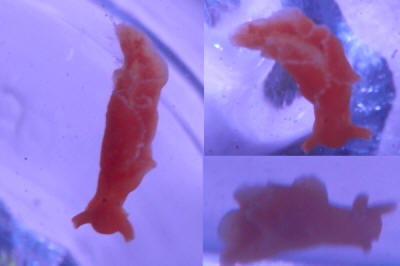 |
Elysia Crispata breeding 1/11/12
Happy New Year Wet Web Media crew!
<And you Gian>
Exciting times in my tank today, I was doing my daily zoning out in
front of the tank, and found what seem to be eggs from a Lettuce
Nudibranch. So far my research has basically come down to Bryopsis as
their main source of food, and depending on its exact species it might
eat Chaetomorpha and/or some types of Caulerpa. I have also read that
the beginning stages of E. Crispata relies solely on photosynthesis,
although I am sure this is all speculation.
Right now I am debating on putting the eggs into the Q/T tank (tank has
never been medicated before, and eggs have been laid on a piece of live
rock), to keep safe from possible predators (i.e. cleaner
shrimp/wrasse/hermits). One issue is the q/t tank does not have the
greatest of parameters and is lit by the Marineland "reef
capable" LED unit, which I do not believe would be sufficient for
the health of the E. Crispata.
<Mmm, there's more to this... the need for a specialized...
perhaps Kreisel type of set up... and nutrient, developmental
monitoring of intermediate stages... Some folks claim success... mainly
through blind neglect: http://www.mbisite.org/Forums/tm.aspx?m=65368&mpage=1
as an example>
It is only a 10 gallon tank, so I could easily do a 100% water change
with tank water from my display, so if that is the route to go I have
no problem doing so. The q/t tank is stocked with live rock, and I plan
on getting all different types of algae to grow for them to eat off. I
will not need this q/t tank for my display for now anyway, so I am
willing to try any sort of algae regardless of its aggressiveness. Main
tank is lit by a 250 watt Metal halide, along with a 150A Kessil. So
the lighting on my display is really pushing me to keeping them in
there. So if there is anything or anyone who has had success breeding
these fun little guys I'd love to read it?
<May require a trip to a large/college library. See here re such
searches: http://www.wetwebmedia.com/litsrchart.htm
Also if it is recommended to move the eggs into the q/t tank, how long
of an acclimation would you suggest, and do you think the tank should
have low flow or higher flow?
<Mmm, better by far to have you search on the Net: "Elysia
Sacoglossan life cycle"
Wiki has nice coverage of E. chlorotica...
Again your help and time is always appreciated,
Giancarlo Santos
<Can be done... Bob Fenner>
|
Elysia chlorotica 12/24/11
Hello,
<Greetings>
I received a Elysia Chlorotica as a hitch hiker on my shaving
brush today.
The slug swims very well and flaps his sides. Do you have any
information on them as to if they are reef safe or poisonous?
<Are reef safe to a large degree... not venomous, nor
poisonous to a great extent. The genus is employed by hobbyists
as an algal control in many places. >
It would be very
appreciated.
Warm regards,
David
<Do see the SeaSlugForum (.net) re this species. Bob
Fenner>
|
|
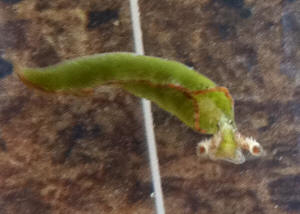
|
|
FOWLR test kit ?? 1/20/11
Hi there, hoping for an amazing day to you!!
<Hello Ingrid. Just waking up is amazing.>
I wanted to know from your advance-expert aquarist point of view,
what is the best or top 3 precise-accurate Test Kits for a FOWLR
salt water system.
<Well if you want the best, the LaMotte Test Kits would be my
first choice, but rather pricey. Next to that, I like
Salifert's kits followed by Seachem.>
And my 2nd question that has nothing to do with the last, I read
your articles about Nudibranch eggs and I'm attaching 2
pictures that appear to be eggs, I just want to be sure
they're eggs and my Nudibranch
are 2 Pacific Lettuce Slug (Tridachia crispate), and both left
eggs.
<Pics are not resolved enough to even take a stab at it. Most
point and shoot digital cameras have a macro feature on them
usually indicated by a flower symbol. If you have one, try taking
a few picks with that and our residential expert on the
subject
(Lynn) can help you out.>
Thank You Very Much !
<You're welcome. James (Salty Dog)>
Ingrid Leija
Follow-up Re: FOWLR Test Kit, Now: Sacoglossan Sea Slug
Egg Ribbon -- 1/20/11
Hi again, James
<Hello Ingrid, Lynn here this evening on behalf of my good
friend, James.>
I'm adding the pictures again; hopefully you can see it
better and give me your opinion.
<Thank you! What I see in the photos is definitely in keeping
with egg ribbons from the various 'Lettuce Sea Slugs'
generally seen in the hobby. I'm not sure which species you
have, but if your individuals were labeled as Pacific Lettuce Sea
Slugs, they could actually be Elysia diomedea from the Eastern
Pacific instead of Elysia/Tridachia crispata (an
Atlantic/Caribbean species). It's not unusual for the two to
be confused. Please see the following link for more information
and photos (including egg ribbons) of Elysia diomedea: http://www.seaslugforum.net/showall/elysdiom
Elysia/Tridachia crispata information/photos: http://www.seaslugforum.net/showall/elyscris
Hope that helps!>
Thank you
<You're very welcome.>
Ingrid Leija
<Take care, Lynn Zurik>
|
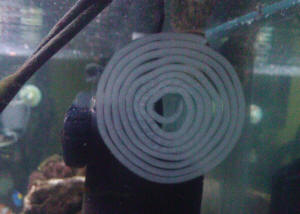 |
Lettuce Nudibranch Compatibility
11/2/2009
Hello all, thanks as always for the excellent info and site.
<Certainly.>
I found this guy at my LFS, I think he is a Lettuce Nudibranch (*Elysia
crispata)*. My understanding is that they are hair-algae eaters.
That being said, I have a moderate amount of hair algae on the back of
my tank, are there specific types they eat, or are all hair algae equal
for dietary purposes?
<Ah I think they will likely take care of most of the green hair
algae.>
Also, I have a damsel, fire goby, and fire shrimp.
Nothing that should eat a Elysia correct? I would like to acquire this
specimen if it is reasonable.
<I don't think it will be a problem compatibility wise.>
Thanks,
-Randall
<Good luck, Josh Solomon.>
|
Lettuce Sea Slug with Bubble on Back
4/15/09
Good Morning,
<Lianne>
As so many have done before me, I'd like to thank all of you
for your generosity in sharing your time and knowledge to help us
make more informed decisions as we build our reefs. I cannot
begin to tell you
how valuable it is to beginners such as ourselves to be let in on
the complicated problem solving that maintaining a healthy
aquarium requires.
<Welcome and thank you>
I have attached two photos showing the back of our Lettuce Sea
Slug, as s/he seems to have a smooth bubble or bump that we have
been unable to identify visiting the Sea Slug forum. We are
hoping you might help.
<Not on: http://www.seaslugforum.net/!? I would send the image
and question to Dr. Rudman directly>
Our reef is 36 gallons with a refugium. It is an open top layout,
and is wider (24x24) than deep (14) with LED lighting. The
current residents, in addition to the Lettuce Sea Slug, are 2
Picasso clowns, 2 cleaner shrimps, 3 glass shrimps, one fire
shrimp, one fighting conch, one blue-legged hermit crab, one
Margarita snail, one Turbo snail, and one tiny, uninvited crab we
are trying to catch (<.5", perhaps a Gorilla), and an
assortment of corals (about 9 at this time). Our test values are
1.025 salinity, 0 nitrite, 0 nitrates, 8.0 ph, .025 phosphate,
Mag 1330, and CA about 450. The tank inhabitants, including the
Lettuce Sea Slug, seem active, curious, and 'happy' and
all eat readily.
Thanks for any identification of this you may be able to suggest
as to whether or not this is: normal-not to worry, unusual-not to
worry, a parasite-start worrying (and you might do this . . .,
etc). We do have
a QT tank set up and ready to go should we need to use it.
Lianne
<I have noted such "vesicles" in wild and captive
Elysia (though I don't know what they portend)... and do
think this is nothing to worry re. Bob Fenner>
|
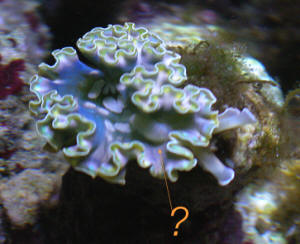 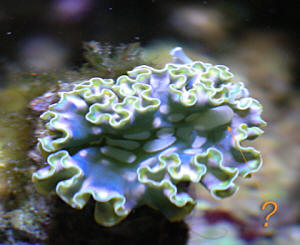 |
Re: Lettuce Sea Slug with Bubble on Back
4/15/09
Thanks so much for your reply.
<Welcome Lianne>
I actually had attempted to email Dr. Rudman, but the SSF is not
accepting messages, saying he is "out of town through the
month of January, and will not be accepting messages again until
February."
<Ahh!>
Not quite sure what this means, as here we are in April, but
perhaps he is on leave until next year.
<Am surprised that he/Bill has not noted the extreme drop-off in
his correspondence... I will try to send him a note in another way
re>
So I really appreciate your prompt explanation.
L.
<Welcome. BobF> |
|
Lettuce Nudibranch -- 03/07/09 Hello all
(ONCE again) <Monique> I have been searching for the past 4
days to figure out an answer to one specific question, I hope you
know that I try using all the resources available to me first, if
no avail then I try you guys... <Ok> Here is the deal: I
recently purchased a "lettuce Nudibranch" (please see
attached picture) at one of our LFS. Its now been about 4 weeks
and has laid a egg coil (from what I've read online
that's what it is). <Yes> What I've read states
that the are hermaphroditic, and as such can fertilize their own
eggs (though not typical). <But might well have done the
"genetic material swap thing" before your, the
store's acquisition... can store sperm> As we only have
one, and are not sure of the exact species, we were wondering if
just ANY two "lettuce Nudibranch" can reproduce
offspring? <Mmm, not across species as far as I'm
aware> Or do they have to be the EXACT SAME kind, to
reproduce? <Maybe posit this query with BillR at
SeaSlugForum... http://www.seaslugforum.net/> There is nothing
that I have found that has answered my questions, I was even on
the SEA SLUG forums looking around regarding my issue. <Oh! A
superlative site> See we would like to get another to see if
the eggs would hatch and have offspring, <Mmm... a worthwhile
speculation... poss. goal... but not easily done by home
hobbyists... do investigate these animals early life
histories...> however we aren't even sure of the
"type" of lettuce Nudibranch we have. I'm thinking
its ELYSIA CRISPATA?? <Might be. Again, send the pic to SSF:
http://www.seaslugforum.net/display.cfm?id=11846> , and of
course like always the LFS is absolutely NO help. When I went in
there they told me "we don't know because we don't
sell those 'things' here". Which was of course
frustrating as I just purchased mine from that exact store about
a month ago!!!! Any help would be GREAT! Thanks for you time! And
again all the help! ~M
<Welcome. Bob Fenner>
|
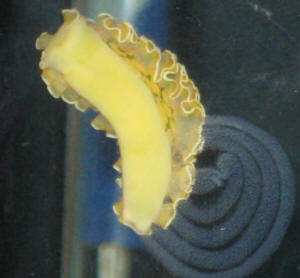 |
|
Slug found...possibly some type of
Oxynoe? 2/20/09 Hi Crew....yes
it's me again *shudder* =) So my wife was bored and looking
at my planted refugium when she found these "snails"
and decided to try and take some pics. I did as much as I could
trying to track them down, and I think I found the genus, that
being: Oxynoe. I am having a time trying to track down the
species, though the Caulerpa I have came from Florida (living in
the frigid north of Minnesota and all, not so easy to find) and I
would say it's a good probability it is indigenous to that
region *wink*, but I haven't found much on those specific
ones. Can you enlighten me on the species? <Mmm... can you
send along some images? Maybe this is O. antillarum:
http://www.seaslugforum.net/showall.cfm?base=oxynanti> Anyway
I think it's pretty neat, and from what I have been reading
is herbivorous and pretty harmless....unless you are a Caulerpa
=). So am I right on this one? *crosses fingers* Thanks crew!!
Justin <Bob Fenner>
Re: Slug found...possibly some type of Oxynoe?
2/20/09 Bob, Sorry about that, I thought I attached the
image to it....doh! Well here ya go =) ( they are pretty tiny
about 1/4" long, so getting a good shot is difficult without
a macro lens for the camera) Justin <Ah! Does look like that
Sacoglossan last mentioned. BobF>
|
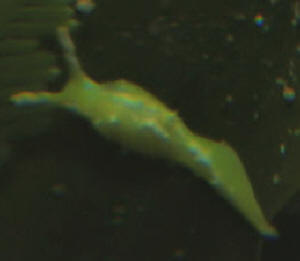 |
|
Shrinking Lettuce Nudibranch 12/8/08 Hello
WWM Crew, I purchased a Lettuce Nudibranch about a week ago to
take care of some small patches of hair algae that won't go
away. <Mmm, this, and other "algae eaters" don't
"eat all" types of algae... Very often one encounters
what you detail here...> It stayed on one rock for a couple of
days and then started to cruse the tank (200 gallon reef). I woke
up this morning to just the head which it is still alive and
continues to move about the rock work. I haven't been able to
find any information on whether this is normal or not... or if
something in my tank caused this (Overflow, Crab or Fish). Thanks
Nick <Mmm... could be a predator... or the gear as you
suggest... In this size/volume system I'd leave it be... hope
for the best, see if it regenerates... As to the algae, I'd
seek other means (competition, nutrient deprivation...). Perhaps
a cursory read here: http://wetwebmedia.com/algaeasfriend.htm and
the linked files above... Your system, from your excellent
photos, seems to be very healthy... just a bit more nutrient rich
perhaps than it should be... Increasing RedOx here, in a few
possible ways, might be the window/avenue to pursue. Bob
Fenner>
|
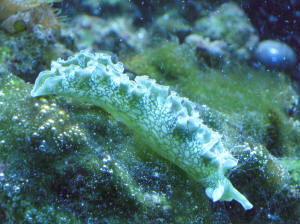 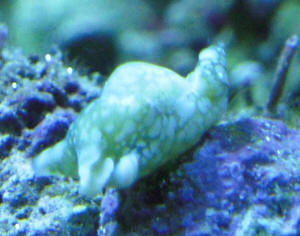 |
Lettuce Sea Slug, as algae eaters... --
09/08/08 Hi all, I have read a couple places that lettuce sea
slugs can be used to control green hair algae...is this true? <...
by and large (in actual application in hobbyists systems, no... These
slugs only eat certain varieties/species... and the types found in
aquariums... are rarely amongst these. Bob Fenner>
Lettuce Sea Slug 3/10/08 This question is for
Scott V. I have a 28gal reef tank with a few peaceful fish and was
wondering how hardy lettuce Nudibranchs were? <Not a true
Nudibranch, actually a slug. These do tend to be a hardier
selection.> I would really like to keep them but don't want to
just watch them die! <The question is one more of food supply in
your tank for the slug. A link to a great article on these for you
below.> Please help thanks. <Welcome, I hope this helps, Scott
V.> http://www.advancedaquarist.com/issues/oct2004/invert.htm
Sea Slug ID: Elysia crispata? Need more information
-- 2/3/08 <Hi there, Victor!> About one month ago, I acquired
some live rocks from the southern part of Puerto Rico, after curing
them I placed them in my marine aquarium. Last week I noticed an odd
creature, which I assume to be some type of sea slug. It is completely
white in color with two antennas and its back is completely covered
with white corkscrew strands. Two days ago I discovered two more of
these creatures, one measures 1 1/4" and the other two 1". To
my surprise, the larger one merged with one of the smaller species and
today I noticed pasted to the glass what looks like a corkscrew rope in
a circle, I assume these are eggs. <You assume correctly!> At
first I thought that these were Lettuce Sea Slugs (Nudibranch) but this
species is not completely white nor do they have those corkscrew
strands on their backs. My question is: What species are these
creatures and do they represent a threat to my marine community? Almost
forgot, I have never seem them on the bottom, they are always on the
glass and move slowly just like a snail. <Hmmmm, here's one
possibility, Elysia crispata. If that's it, I'm going to go buy
a lottery ticket! Please see these links:
http://www.seaslugforum.net/factsheet.cfm?base=elyscris and
http://www.seaslugforum.net/display.cfm?id=10414 If that's not it
(or if it's close), then an ID is going to take some research. What
I would recommend is to go through the following links and try to
determine which family your sea slug shares the most characteristics
with. Start here: http://www.wetwebmedia.com/seaslugsopisthobranchs.htm
. Then see the three pages starting here:
http://www.wetwebmedia.com/nudibran.htm , especially the section on
page 3 titled 'The Big Three Aquarium Problems with
Nudibranchs'. Once you determine a likely family, you can then go
to the Sea Slug Forum and look through the species listed in that
family: http://www.seaslugforum.net/. It's a lengthy process, but
you might just find your little slugs!> Best Regards and Thanking
you in advance, Victor. <You're very welcome and good luck! Take
care. -Lynn>
Sea Hare ID -- 09/25/07 Hi Bob,
<George> We took a shot of this animal and although it seemed
like an Aplysia dactylomela at first we have second thoughts now.
First because it was shot three days ago in the Mediterranean (and
not the Caribbean) and second because it doesn't show the
typical "wings" on its back. <Mmm, yes, but...> Do
you know what this species is ? Needless to say, you can use the
photo for your site (a higher definition photo can be sent to you
if you need it for publication). <Looks like Aplysia dactylomela
to me...> Best regards and many thanks,
George Reclos |
|
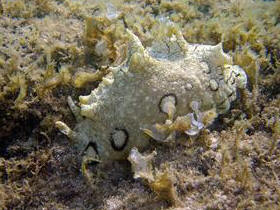
|
Elysia viridis. Looking For A Bryopsis Grazer - 05/06/07 Good
Morning all, <<Greetings>> I have been working on a
Bryopsis problem for a while now and have been doing regular water
changes to combat the situation. <<Have you looked through our
info re nuisance algae? Raising your system's pH to 8.5/8.6 and
keeping it there for several weeks has shown anecdotal proof of helping
to eliminate this pest alga>> My battle has lead me to research
additional means. <<Ah...ok>> I have found that a sea slug
of the order Sacoglossa, Elysia viridis, has made claims to eat
Bryopsis exclusively. <<Mmm, not "exclusively"...at
least not according to seaslugforum.net>> The problem I am having
is finding this slug in stores? <<I think this animal is more a
cool/temperate species than a tropical species, based on its
distribution in the Northeast Atlantic>> I have been told my LFS
that the Lettuce Sea Slug is the same thing as the Viridis, however I
am not sure if they are. <<Elysia crispata (Lettuce Sea Slug) is
a distinctly different species from E. viridis hailing from different
locales...and quite apparent when viewed>> I know they are of the
same family but not the same species? <<Correct>> Can you
help me decided on whether or not to buy a Lettuce Sea Slug for my
battle, or if not, where I can obtain an Elysia Viridis? <<I
would NOT buy the Lettuce Sea Slug. Little is known of what these
animals really eat (even though they are actively marketed/sold as
grazers of "hair algae"). Many of these slugs are able to
harbor the living chloroplasts of the algae they consume which continue
to photosynthesize within the body of the sea slug, providing it with
sugars for its own nutrition. E. crispata have been found to contain
the ingested symbiotic plastids from Halimeda incrassata and Penicillus
capitatus...hardly "hair" algae. My own anecdotal
observations and experiences would seem to bear this out as I have
never known one survive more than a few weeks to months in a home
aquarist's system, even with an abundance of hair algae present, as
they all seem to ultimately shrink and die from starvation. I think a
better choice of slug to try would be from the genus Aplysia...the Sea
Hares. These slugs; at least in my opinion/experience, are more hardy
and much more likely to consume the filamentous algae than E.
crispata>> Thank You for Your Time <<Happy to share.
EricR>>
Lettuce slug hurt 2/14/07 Hi. I have had a beautiful Lettuce
Slug for 3 weeks now in an 29 gallon. <Mmm, not easily kept... esp.
in such small volumes> She was doing fine and eating algae. But I
noticed last night that her back "flowery" section has a
slight tear. She seems to be ok. I have a fire shrimp and a Short
Spined brittle star. I don't think the Shrimp would do it. The
Starfish? <Both, either could> Or, sometimes the current lifts
her up and flies around into she can get hold of a rock or coral. We
have lots of rocks and coral? <Maybe... the worst is to get
"sucked up" against an intake...> Is she so fragile that
that would do it? <Easily> And, is there anything I can do for
her. I have grown very attached to her and love her as a pet. Any
suggestions? Dana <What little I know is posted on our Opisthobranch
areas: http://www.wetwebmedia.com/seaslugsopisthobranchs.htm and the
linked files above. Bob Fenner>
| Fuge hitchhiker ID, Green
Slug'¦.. 1/28/07 Greetings Bob & Crew!!
<Hello.> The other evening, I wandered through my fish
(laundry) room and stopped to look at the pods crawling around my
40-gal sump from my 125 reef in the next room. I swear I saw a leaf
from one of the algae move....and I realized that it was alive!!!
It looks like a land slug, but all green. Only about an inch long.
No idea how long it has been in there or when it came in. It seems
happy to crawl around the ample macro algae in the tank and just
graze. I've done a few searches and can't seem to find
anything like it. Any ideas what it is??? Pic attached. <Well,
from the photo it does appear to be a Nudibranchia. I will say
first off that by photo alone 'even with the actual
specimen in front of you, it is quite difficult to i.d. by exact
species. They are mostly very, very difficult to care for and have
notoriously short life-spans in captive environments. However,
occasionally, some survive'¦.as appears to be the case
with yours. It likely has a food source, and judging from the color
of the animal, (as you eluded to) it appears to negotiate a large
sum of vegetable matter, algae, into it's diet. I would just
observe and enjoy.> <<Mmm... likely another Opisthobranch
group... a Sacoglossan. RMF>> Thanks <Anytime.> -Ray
<Adam_J.> PS GO BEARS!!!!! <We don't have a football
team in SoCal'¦.lol.> |
|
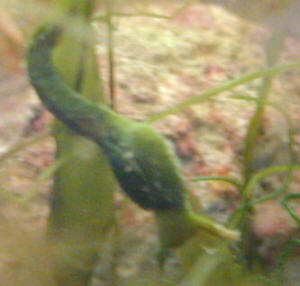
|
Lettuce Nudibranch or Elysia Crispata Eggs - 1/18/07 <Hey
Michelle, JustinN with you today.> I just bought one of these
magnificent creatures last week and it has laid an egg strip in my
tank. How long does it take before the eggs hatch and should I turn off
my protein skimmer and cover the bottom of my filter so that the larvae
don't get sucked up? Any info at this point would help. Thank You
Michelle Worley, Ohio <I'm sorry, Michelle, but I can't seem
to find any solid information on the gestation period of Elysia
crispata eggs. Shutting off your protein skimmer will likely increase
the chances of survival here. Good luck! -JustinN>
Lettuce Sea Slug/Systems 4/10/06 I have 4 lettuce sea slugs
in my 29g reef (yeah, probably 2 if not 3 too many). <Maybe four too
many.> I have had them in there for a couple months. Only one of
them explores the entire tank, another explores sometimes, but the
other two and the "sometimes" one mostly hang out on the
glass at the top of the tank, in the direct flow of my power filter and
obviously near the light, and the two don't move hardly at all. I
have a couple of times taken them all and placed them within the rock
but they end up back at the tank top. My question is, is this
considered "normal"? I figured they are partially
photosynthetic but they are getting little if any solid food, other
than what they may be filtering/catching in the water flow. should I be
concerned with their health?
<Yes, the Lettuce Sea Slugs are photosynthetic but need sufficient
green algae to survive. Without providing this they will soon
perish.>
they so far don't seem to be adversely affected, at least on the
outside. Patrick <James (Salty Dog)> 29g, Prizm skimmer,
Marineland bio-wheel 200, 2x65w compact fluorescent, about 30lbs live
rock, 1 goby and 1 blenny, several hermits and Astrea snails.
Elysia crispata nutrition/feeding 1/18/06 Hi my name is Beth
and I just received an Elysia crispata as a gift. As interested as I
was with this gift, I know it can spell disaster if I do not get enough
information on him as quickly as possible. Basically I need to know if
it will eat Caulerpa or not. ( I have heard contradicting answers).
<Some do, but not exclusively, enough... and can be trouble> Also
I do not have strong enough lighting for corals but my macro algae does
great... maybe too great. If this guy needs a different environment let
me know, and if the Caulerpa isn't appropriate please tell me what
is ... along with the common name so that if I need to get some even
the kids at the store will know what I am talking about. Thank you for
your time... my lettuce slug thanks you to! <Mmm, more fine,
filamentous greens. Please see here: http://www.seaslugforum.net/display.cfm?id=12310.
Bob Fenner> - Beth
|
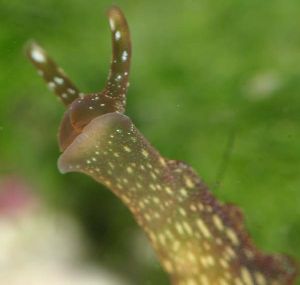 Sacoglossans Sacoglossans
|
| Leslie's Lettuce Nudi - 10/24/05 Hi Bob
and Fellow Crew Members, I seem to have a little troublemaker in my
tank. This cute little guy showed up a week or so ago. I noticed my
gorgeous piece of Maiden's Hair or Turtle Grass (Chlorodesmis)
slowly getting smaller and smaller. I wondered where it was
disappearing to since there was no evidence of it
"shedding" and seemingly disintegrating like one I had a
while ago did. This afternoon I noticed this little guy in the
middle of what is left of my poor pathetic looking Maiden's
hair and am pretty sure he is responsible for it slowly diminishing
in size. Can anyone ID this little guy or know what other trouble
it might cause in my seahorse corral? I have some gorgeous red
macros Meristiella and Botryocladia. The Meristiella seems to be a
fast grower and is growing amazingly well. I wonder if this critter
likes red macro as much as he seems to like greenery? Will my reds
be next? Thanks so much, Leslie <Although mine are paler in
color, it looks identical to my lettuce Nudibranch. HTH,
Jeni/PP> |
|
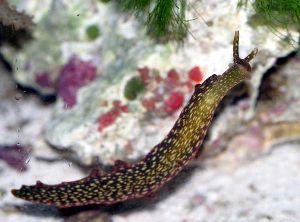 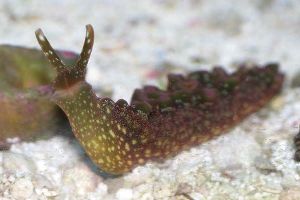
|
|
<<Leslie, This critter looks a lot like the group of slugs
sold as "Lettuce Nudibranchs". Ounce for ounce, they
are quite voracious herbivores, although sometimes they are quite
specialized in what they eat. There is no doubt what this one
likes! These critters are totally safe to tankmates, but are
often harassed and picked on. They also are quite easily injured
or killed by powerheads, drains, pumps, etc. The most specialized
can starve when their preferred food source is exhausted. I would
suggest that you either remove it to salvage what is left of your
Maiden's Hair or enjoy it as long as it survives. If you
remove it, pass it along to someone else that is trying to
contain a nuisance algae problem. If it isn't all that
specialized, they can help. Adam C>>
Leslie's Lettuce Nudi - de Justin I'm about
99.999% sure that it is a lettuce Nudibranch. The only thing that
is stopping me for a second is the color. This guy eats algaes of
all types and its color becomes what it eats if you will as it
uses the plant chloroplasts and puts them in its skin and uses
them to make food for it as well. Very interesting character and
other than being very algae unsafe its a great animal. If you are
a macro algae loving person then remove it ASAP. Otherwise let it
do its maintenance chores and save you some scrubbing. If you
don't want it ill be glad to take it, I love the little
tykes. Justin - Jager
|
Reef Safe Nudibranch - 3/28/03 I am very sorry I tried to
look this up but either I am looking in the wrong places or I am blind.
<No problem> I just want to know if they are reef safe.
<Elysia (sometimes referred as Tridachia) crispata are known to be
reef safe. Check on the forums at the many reef sites and more
importantly check out http://www.seaslugforum.net and
http://www.wetwebmedia.com/grnalgcont2.htm
Please take the time to learn about the environmental conditions and
the specific needs of this useful but delicate animal> My LFS has a
real nice looking one and I want it but don't want to loose coral.
Any help is appreciated. <No worries. Paul> Shane
Green Slug Hi Bob, thanks for your info on the Fingerfish. I
got a Green Sea Slug (Elysia) last week. It is doing fine. Yesterday,
it started to lay eggs in a spiral pattern. Are those eggs? <Yes>
Will they hatch? <Perhaps.> Will they live? <What will they
eat? What is the species life cycle, developmental history? Insert the
name in your search engines and find out. Bob Fenner> Thanks.
| Lettuce Sea Slug Hey Gang,
Happy Holidays! Anthony, (or whoever's in charge of desktop pic
on daily questions page), I took these pictures earlier today. I
thought they might look good on the WWM site for the daily pic!
Thanks from Denver! Stormbringer. <What a coincidence... I was
just scanning an Elysia (Tridachia) crispata yesterday... Your
digital pix are better than my analog. Thanks for sending them
along. Bob Fenner> |
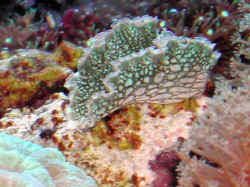 |
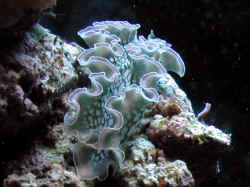 |
Feeding lettuce Nudibranchs <Hi Kerry, MacL
here> I am wondering what types of algae the lettuce Nudibranch
eats?
<I'm quoting here from http://www.seaslugforum.net/display.cfm?base=elyscris&id=3863.
"In choice experiments they found that E. crispata would eat a
number of species of siphonaceous green algae including Batophora
oerstedi, Bryopsis plumosa, Halimeda spp, Penicillus spp, Caulerpa
paspaloides and Caulerpa racemosa. Jensen & Clark (1983) later
showed that another species of Caulerpa, C. verticillata (a very finely
branched species, which looks a bit like a tiny Christmas tree), is the
preferred food of the juveniles of this species."> And a second
question is what kind of algae is the green film that grows on the
glass of the tanks and is this one that the Nudibranch eats?
<Difficult to answer could be several different types.> Thanks
for All the info on you website It is my main source of Info in the
hobby. <so glad its been of help to you. Good luck, MacL>
Missing Nudibranch Hi guys, hope you're all doing well...
<< I am. >> Was hoping you might shed some light on a new
addition gone MIA. I added 2 lettuce Nudibranchs to my tank a couple
days ago as part of a two-fronted attack on hair algae (finally got an
RO/DI-- Kent Maxxima-- fertilizer-free water changes to come!), but one
of the fellows has gone missing during the 1st night. << Are you
sure. They may hide well. >> No signs of it stuck against a power
head (all are screened off), & no sign of him in the overflow
compartment either. I'm wondering if a tankmate may have eaten him.
<< Possible, but I'll say unlikely. >> Basically my
inhabitants are currently a Mandarin Dragonet, 2 Green Chromis, a
Lysmata amboinensis shrimp, a Spiny Brittle star, a Favia brain coral,
some Discosoma & Rhodactis mushrooms, assorted red & blue
legged hermit crabs + one scarlet reef hermit, & some Astraea &
turbo snails. My 1st suspect is the brittle star-- I'm thinking
that with his long searching arms it may have come across it &
probably could have caught it pretty easily. I don't think this guy
is actively predacious, but could be opportunistic? << Doubtful.
I wouldn't think of him as the problem. >> My next suspect is
the scarlet reef hermit. The only reason I really even consider him is
because I had caught him eating a "Red Footed Conch" that I
had (never was able to truly id this guy). << Well, that is
possible as well, but hermits are more of scavengers and are more
likely to eat it something that has already died. >> The hermit
would pry open the conch's little 'door' & was picking
out matter from inside. I removed the conch & put him in the fuge,
but it didn't make it. I haven't caught the hermit assaulting
any of the Astraea or Astro, but one wonders... My last suspicion is
the Rhodactis mushrooms. One of them is about 4 inches across, & I
have seen them close up on morsels that drift onto their surface. I
wonder if the Nudibranch could have floated onto one accidentally &
been consumed before he could high-tail it off? << Doubtful
again. >> What do you think the likelihood of any of these
scenarios seem to you? Are the lettuce Nudibranchs
'distasteful' enough that these shouldn't be a concern?
<< I would bet he simply just died. They aren't that hardy
and being transitioned into a new aquarium may have just been too much.
They often get blown around by powerheads into the rocks and things
like that. I wouldn't think it was predation, so much as
unfortunate circumstances. >> I'm trying not to assume the
worst, & bearing in mind that he could have just gotten into the
rockwork somehow & not being plainly visible, but I'm also
thinking that because these guys are partly photosynthetic, that they
should hang out in the light, on rocks' surfaces, more or less,
right? Thanks for any insight you can offer... << I'd
probably not try another. If you are having a hair algae problem
I'll assume you have a water issue problem. I don't like adding
delicate items to a system with water problems. >> Pete Cushnie
<< Blundell >>
Lettuce sea slug.... Hello, I checked the FAQ page I was
directed to, but found no info regarding this...I have a lettuce sea
slug. It a appears that it has shed its frills...it is much shorter
now, grazing on rock, a nub of its former self. I saw the frills
briefly, but they have not reappeared. Did it divide itself or was it
chomped in two.
<< I doubt it divided in two. It is possible, but I don't
think lettuce sea slugs are known for that. Why did you buy one? Most
people buy them to control Aiptasia, <<??? What AdamB?
RMF>> and they do very well. But after it consumes all your
Aiptasia, they will often starve. Something to keep in mind, in case
your tank is Aiptasia free. >>
I have no experience with sea slugs, I've had this one about a
week. Thank you, Beverly << Sorry I can't be of more help,
let me know how he looks in a few days. Adam Blundell >>
|
|

